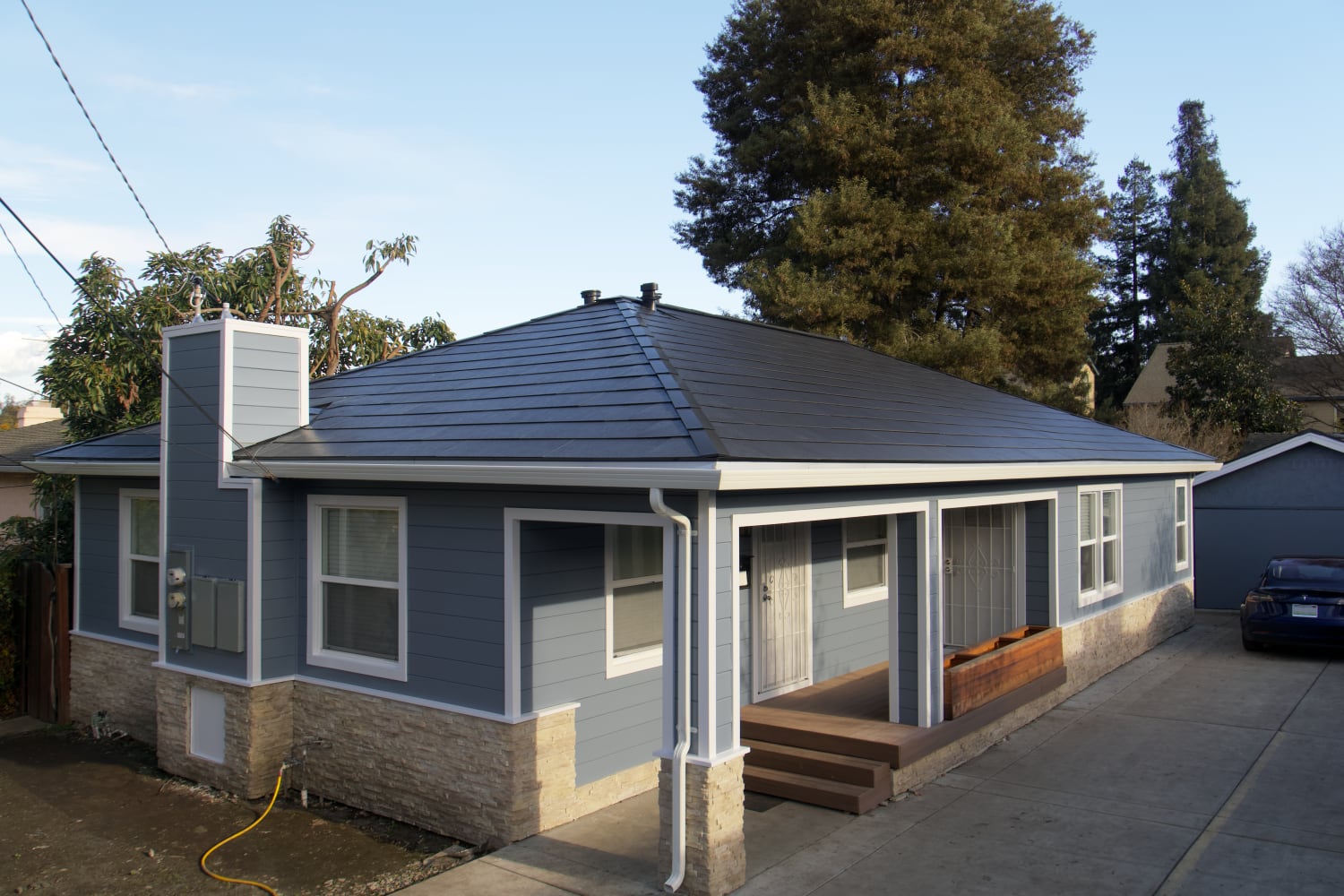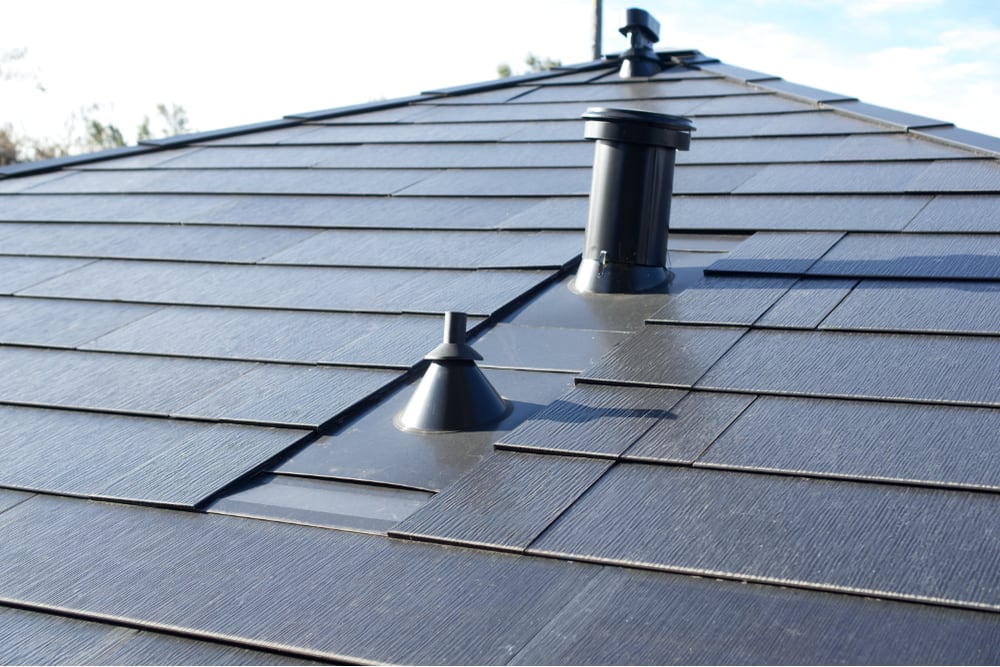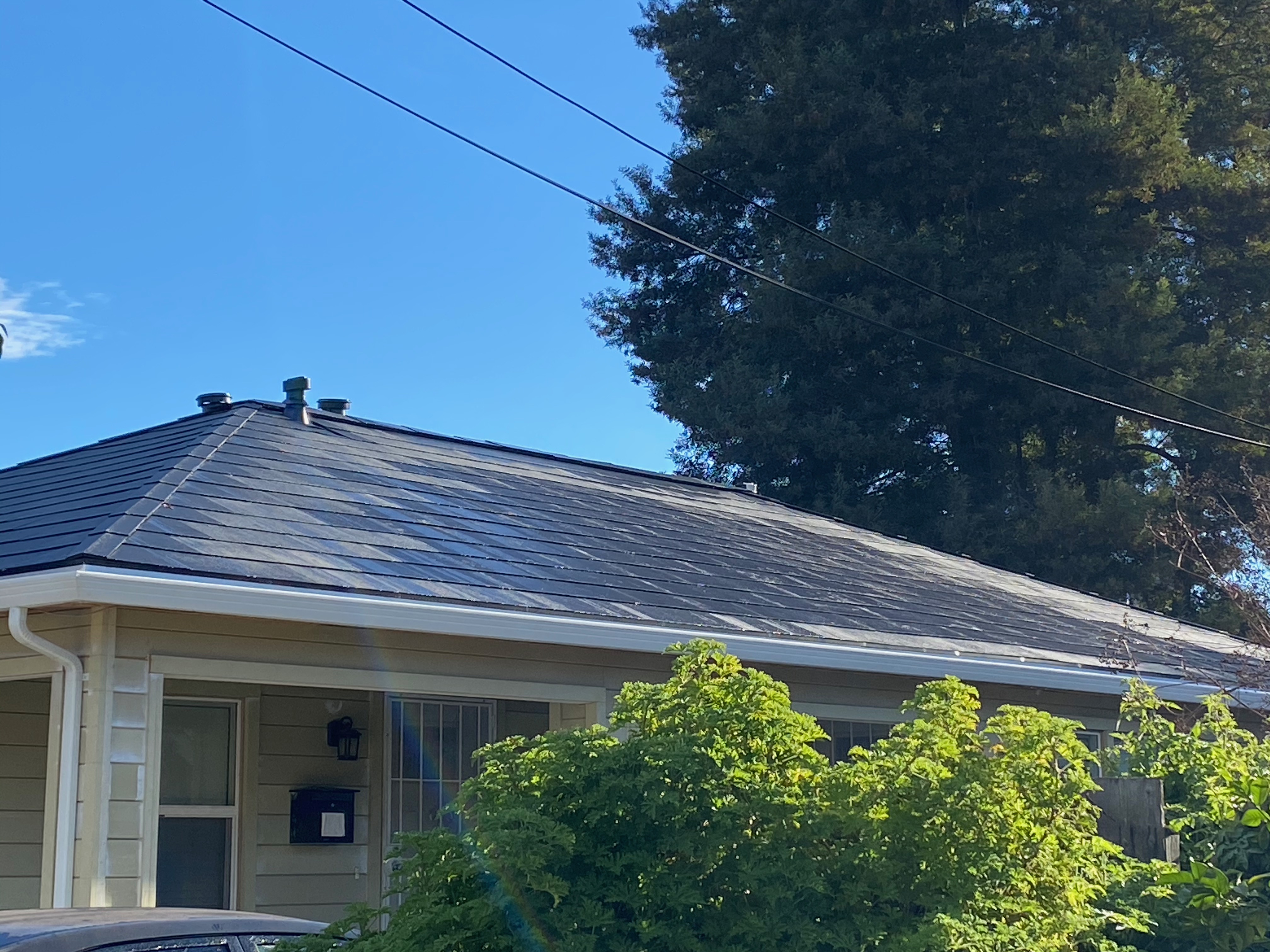The Tesla Solar Roof
This is what you're here for—the Tesla Solar Roof.
The Solar Roof isn't just a few fancy-looking solar panels that go on your typical roof. Instead, it's a complete integrated system, featuring:
- Solar Tiles that take sunlight and convert it into DC power. The Solar tiles are made of textured black tempered glass and contain power-generating photovoltaic cells.
- Non-solar Tiles, which exactly match the aesthetic of the solar tiles, and are prefabricated and selected fill in your roof in non-solar spaces.
- Metal Trim, Vents, and Flashing on roof edges and corners that enhance weatherization and match the aesthetic of the roof tiles.
- Inverters and Electrical Hardware to take the DC power and convert it to AC for your home.
Our Roof Configuration
Before installation, Tesla gave us a bid with several potential roof configurations that target different power or backup needs. We chose to install the “Max Solar” option for our v3 Solar Roof, based on what we’ve had already saved after signing v1 (and later v2) contracts.
The roof is forecasted to meet 110% of our current energy needs—but this is before we added EV charging to the equation. We use about 17-25kWh of energy per day in our house, and the roof has generated about 15kWh per day this winter.
Crash Course: What's a kilowatt?
Kilowatt: Real-time Power Consumption
A kilowatt, or 1000 watts, is a unit of power that quantifies a rate of energy transfer.
| Item | kW / Power |
|---|---|
| Average Phone Charger | 5–12 W |
| Gaming Computer | 500–900 W |
| Toaster | 1 kW |
| Electric Dryer | 5 kW |
| Level 2 Car Charger | 8-10 kW |
| Electric Water Heater | 10 kW |
| Tesla Supercharger | 72-250+ kW |
Kilowatt Hour: Total Energy Use Over Time
If a kilowatt is a measurement of power consumption, a kilowatt hour (1 kWh, 1000 Wh) is a measurement of energy consumption, of one kilowatt over one hour.
| Item | kWh / Energy |
|---|---|
| iPhone 11 Pro Max Battery | 15.04 Wh |
| MacBook Pro 16" Battery | 99.8 Wh |
| Maximum TSA-Approved Portable Battery | 100 Wh |
| A Load of Dishes (Dishwasher) | ~1.3 kWh |
| A Load of Laundry (Wash & Dry) | ~3.8 kWh |
| Tesla Powerwall 2 | 13.5 kWh |
| Tesla Model 3 Long Range | 72 kWh |
Solarglass Tiles
The Tesla Solarglass tiles are glass textured roof tiles that include integrated photovoltaic solar cells, which produce Direct Current when exposed to the Sun.
The photovoltaic cells in the Solarglass tiles are quite similar to the cells used in typical solar panels. But the Solarglass tiles are your roof, not a component on top of it—the PV cells are under the impact-resistant tempered textured glass.
The Solarglass tiles are interconnected in strings to produce high voltage DC, which is converted by inverters into alternating current. The AC is selectively fed to our house, Powerwalls, or the grid—depending on how I’ve configured the system in the Tesla app.
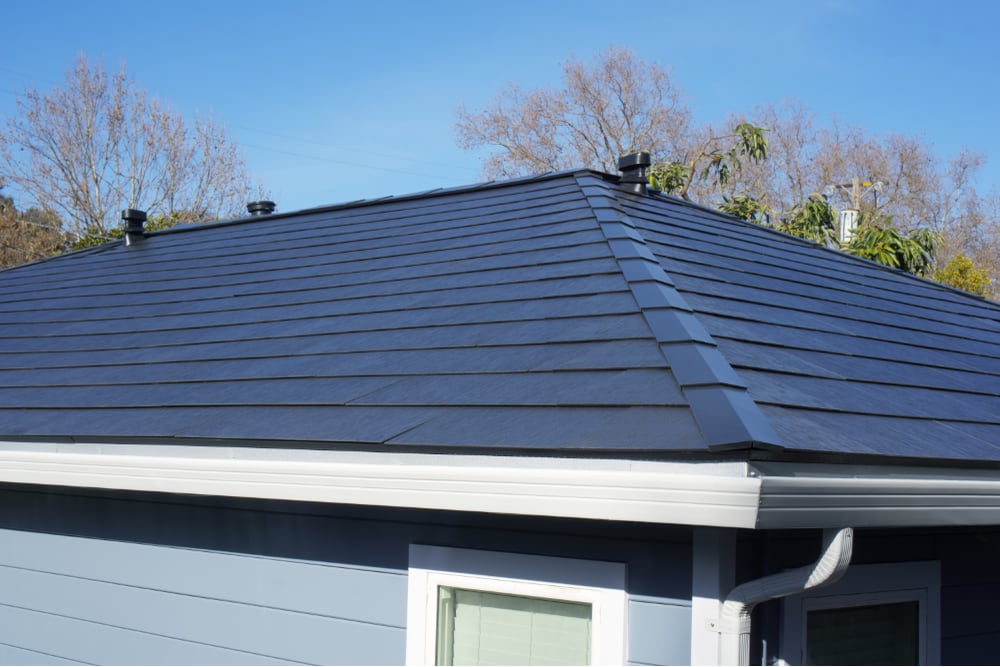
This is a medium-distance shot of the roof that sort of simulates "eye-level"...if you were 6'5".
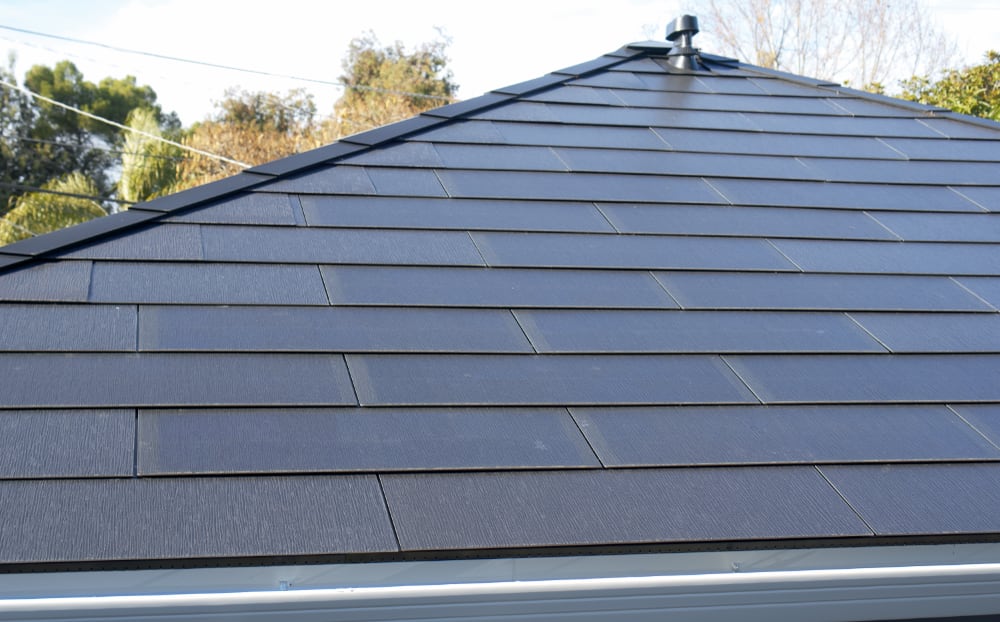
Looking down on the tiles at a steep angle reveals the inner Photovoltaic cells. These's aren't visible from eye level or the street.
What convinced you to get Solar Roof?
The Tesla Solar Roof presented us with the most economical, clean, future-forward all-in-one solution.
When we bought our house, it had an old leaky roof, and we had vaguely intended to also get solar at some point. Not too long after our house purchase, Tesla announced the v1 Solar Roof, and after less than a week of discussion, we put down a deposit for it.
We’re also environmentally responsible and care a lot about reducing our impact on the earth: we drive EVs, we recycle, and we do our best to make purchasing decisions centered around longevity and sustainability. Therefore, solar is a no-brainer expense for us.
For where we live, it’s also cheaper than replacing our old, broken roof and getting solar in separate steps.
Aesthetics
If you’ve been following the Tesla solar roof for a while, Solarglass v3 certainly changes the aesthetic of the product.
Even with the increased size of the v3 roof tiles, which is intended to reduce installation complexity, Tesla has followed through with its promise of delivering an aesthetically pleasing roof with solar capabilities. (If you don’t agree, that’s okay too, but don’t be annoying about it.)
Solar Cell Visibility
If you’re looking at the roof from the ground (or eye level), the solar tiles look identical to the non-solar tiles 99% of the time. I know which tiles are which on my roof...and even when I look hard I can't tell the difference.
Many of my photos above are taken from angles above the roof looking downward onto the tiles—this is an artistic decision to reveal the photovoltaic cells in the Solarglass tiles. (Still, it's hard to get the PV cells revealed in a photo unless you have the exact right angle and lighting. I have hundreds of discarded photos.)
All this being said, in rare conditions, I've seen the difference in solar vs. non-solar tiles from street level just once. My presumption is that it's the right mix of outdoor temp, condensation, and the difference in thermal mass between the tiles.
Nitpicky Technical Specs
We have 10.37 kW of solar installed on our house, spread across five roof segments: 2 segments facing 228º, 2 facing 48º, and another facing 138º, all with a 22º roof pitch. The solar strings connect to 3 Delta Solivia solar inverters, one of which is on our garage, which handles that roof alone.
As far as more detailed specs go, it seems like Tesla is trying to create a market segment where consumers evaluate system specifications based on the product as a whole, rather than providing scores of intricate details that are not individually significant. (You know, similar to that of a Rolls Royce car—“the horsepower is sufficient”).
I know things like per-panel specs are popular discussion topics when it comes to typical solar installs, so here’s some stat extrapolation and speculation. Based on my best guesses: our roof has 178 Solar Roof v3 tiles, which produce ~58.25W of power per tile.
Here’s the complicated bit that could get misleading fast: by space utilization, this is equivalent to 8.7 W/ft2. This is about half that of a conventional solar panel like the LG 335W (as an example), which provides an energy yield of about 15.9 W/ft2. It’s important to note this is a false equivalence. Conventional solar panels try to min/max solar cell density in the smallest available packaging and don’t necessarily need to account for the weather and impact resistance that is required from the Solar Roof. Tesla’s Solar Roof balances good aesthetics, durability, and construction over just space utilization. These different goals don’t make them any less suitable for your roof.
In fact, we have just over 1kW of Solar Roof tiles installed on a small region of our roof that faces nearly directly east—for optimal solar production—where we would be unable to mount even two conventionally sized solar panels. The placement of conventional solar panels is limited by things like code-enforced setbacks like distanced from roof edges—something our city is quite a stickler for more than others. Solarglass can also wrap active cells neatly around things like vents.
How much does weather influence solar generation?
How much does weather influence solar generation?
A ton. There are two primary weather factors: seasons, and cloud cover.
Seasons
During summer, the days are long, and the Sun sits high in the sky. The Sun's energy is more direct, and there's more of it with the longer days. You get more solar energy per day.
Conversely, in winter, days are shorter, and the Sun sits lower in the sky. The days are shorter, and solar panels that aren't optimally positioned may fail to get significant amounts of Sun. (I haven't been through a full winter/summer cycle to say for sure, but as far as I can tell, winter production is usually 40-60% of summer production, depending on the particulars of your install.)
As the days change while we're transitioning out of winter, we're steadily seeing new peak power values around noon-ish from our Solar Roof every few days. I can't wait to see what summer brings.
Cloud Cover
As a kid, I loved reading books near an open window on rainy days. You know when, suddenly, the Sun pokes through the clouds on a cloudy, rainy day, and it gets way brighter in a short time?
Clouds block solar irradiance. The photovoltaic cells need Sun exposure, or insolation, to produce power. Indirect insolation, when the Sun is behind clouds, produces substantially less power than direct Sun contact.
Depending on the weather, there can even be a dramatic effect when you have a day with fast-moving patchy clouds. In just a matter of seconds, you can go from less than a kilowatt of power to nearly maximum production.
Clouds turn me into, literally, a millennial yelling at clouds.
Are there power optimizers or microinverters?
Are there power optimizers or microinverters?
No.
(Quick context for this aside: Power optimizers and microinverters are add-ons in typical solar installations—the exact choice of which depends on the product ecosystem around your inverter—that help to negate or minimize the effects of shading or other inefficiencies in your solar strings.)
That said, as far as I can tell, Tesla’s installation decisions for our house reduce any particular need for them. There are several different strings of solar that run into three different inverters.
For our install, I think the only section of roof that would benefit from optimizers or microinverters long term is our garage. The garage isn’t very tall, and there’s a small maple tree that will cast some shadow on the garage. As for everything else, once we have our giant tree removed, there’ll be no shade at all over the majority of our roof.
Should you really have had solar installed on your garage?
You know, good question. The case isn’t fully in the “yes” department here.
Based on early numbers, it’s the lowest production segment of our roof, but also the smallest part of the solar install. If Tesla’s v3 offer didn’t come at a time where it was easy to approve the “Max Solar” option of the Solarglass v3 (which was still far cheaper than the overall smaller install of the v2 contract we had before), then we’d have skipped it and only installed the non-solar solarglass tiles on the garage.
All that being said, even with some shadows, it still produces a nice chunk of energy. So, I’m not complaining.
